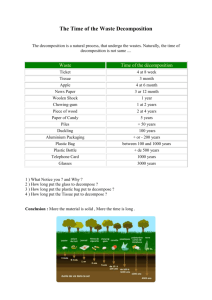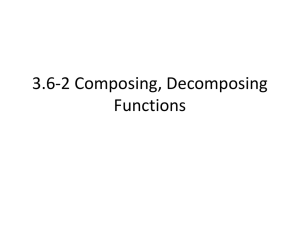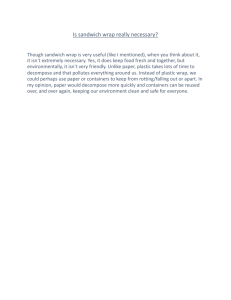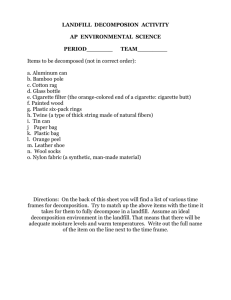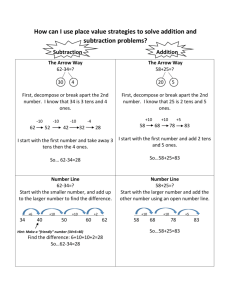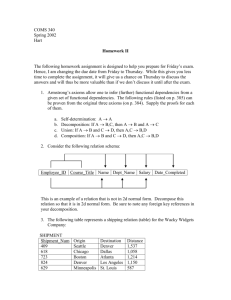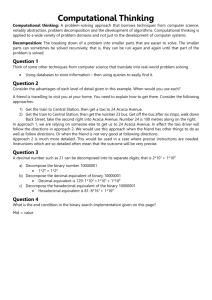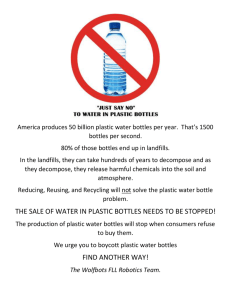Trash or Treasure
advertisement
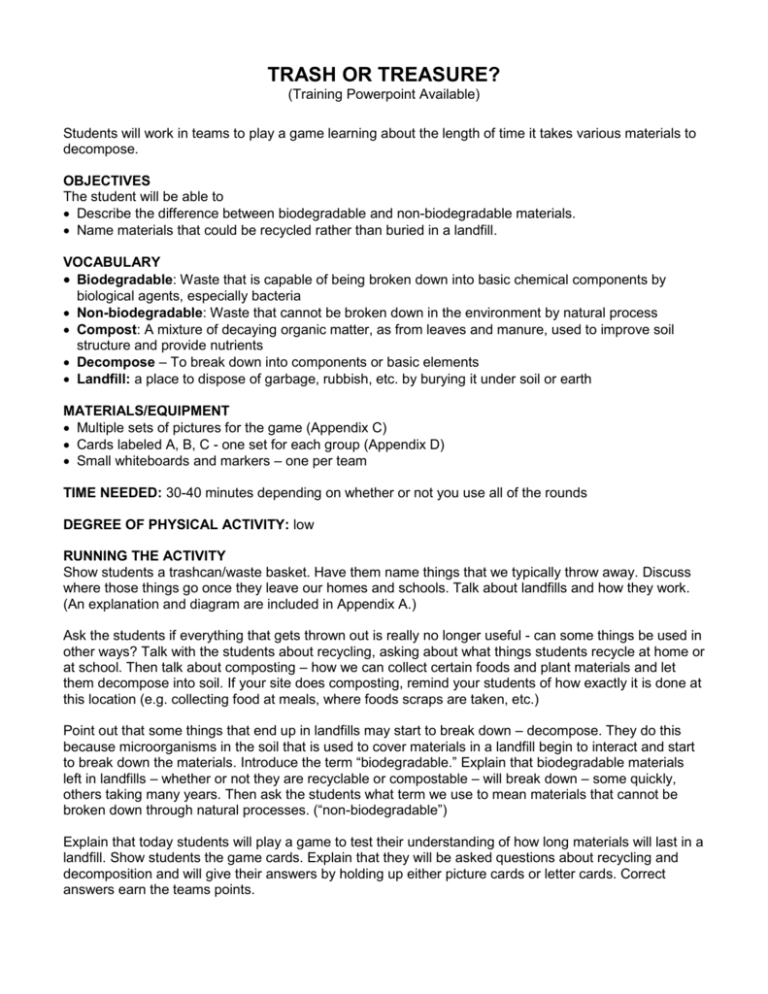
TRASH OR TREASURE? (Training Powerpoint Available) Students will work in teams to play a game learning about the length of time it takes various materials to decompose. OBJECTIVES The student will be able to Describe the difference between biodegradable and non-biodegradable materials. Name materials that could be recycled rather than buried in a landfill. VOCABULARY Biodegradable: Waste that is capable of being broken down into basic chemical components by biological agents, especially bacteria Non-biodegradable: Waste that cannot be broken down in the environment by natural process Compost: A mixture of decaying organic matter, as from leaves and manure, used to improve soil structure and provide nutrients Decompose – To break down into components or basic elements Landfill: a place to dispose of garbage, rubbish, etc. by burying it under soil or earth MATERIALS/EQUIPMENT Multiple sets of pictures for the game (Appendix C) Cards labeled A, B, C - one set for each group (Appendix D) Small whiteboards and markers – one per team TIME NEEDED: 30-40 minutes depending on whether or not you use all of the rounds DEGREE OF PHYSICAL ACTIVITY: low RUNNING THE ACTIVITY Show students a trashcan/waste basket. Have them name things that we typically throw away. Discuss where those things go once they leave our homes and schools. Talk about landfills and how they work. (An explanation and diagram are included in Appendix A.) Ask the students if everything that gets thrown out is really no longer useful - can some things be used in other ways? Talk with the students about recycling, asking about what things students recycle at home or at school. Then talk about composting – how we can collect certain foods and plant materials and let them decompose into soil. If your site does composting, remind your students of how exactly it is done at this location (e.g. collecting food at meals, where foods scraps are taken, etc.) Point out that some things that end up in landfills may start to break down – decompose. They do this because microorganisms in the soil that is used to cover materials in a landfill begin to interact and start to break down the materials. Introduce the term “biodegradable.” Explain that biodegradable materials left in landfills – whether or not they are recyclable or compostable – will break down – some quickly, others taking many years. Then ask the students what term we use to mean materials that cannot be broken down through natural processes. (“non-biodegradable”) Explain that today students will play a game to test their understanding of how long materials will last in a landfill. Show students the game cards. Explain that they will be asked questions about recycling and decomposition and will give their answers by holding up either picture cards or letter cards. Correct answers earn the teams points. Depending on the group, you may want to take a time at the start of the game to discuss the fact that there are variations in how long scientists think it will take for some materials to decompose. Sometimes, sources disagree on exactly how long it will take because decomposition depends on factors like the amount of sunlight, moisture, and air exposure. If the materials are tightly packed and covered, decomposition will take much longer. Sometimes, the materials will break down into smaller and smaller pieces, but it will never really go away. If students question the values, use this as a teachable moment. Talk about the challenges of knowing the long-term consequences of using materials we’ve created, like plastics or styrofoam since they’ve only been used for a relatively short time. Scientists and engineers make educated guesses for decomposition rates based on their understanding of the chemical structure of the materials and how they will interact with chemicals found naturally in the environment and chemicals we introduce. For this game, the times given for the decomposition rates are averages. Divide the class into several groups and position them around the room. Have chaperones sit with the groups – they can be responsible for keeping scores. Pass out one set of picture cards and a set of letter cards (for multiple choice questions) to each group. Give them a few minutes to familiarize themselves with the cards and to ask questions about any images with which they may be unfamiliar. The Game First Round: Have each team to look at their pictures and choose the three things that will take the shortest amount of time to decompose if left our in the open. Groups score 10 points for each correct answer. Correct answers include facial tissue (1-2 weeks), paper towels (2-4 weeks), banana peels (1 month), and newspaper (6 weeks). Second Round: Have each team to look at their pictures/objects and choose the three things that will take the longest amount of time to decompose if left out in the open. Groups score 10 points for each correct answer. Correct answers include electronics (millions of years), glass (1-2 million years), tinfoil (unsure/never?), styrofoam (unsure/never?) Third Round: Show the groups the pictures of the milk carton and the plastic milk jug. Tell them one will decompose in 5 years and the other will take about 500 years to decompose. Have them choose the picture of the one that will decompose first (in 5 years) from their set of pictures. On the count of three, the groups should hold up their choice. Groups score 10 points for the correct answer: milk cartons. Fourth Round: Show the groups the tin can and the aluminum can. Explain that one will decompose in 50 – 100 years while the other one may never decompose – scientists aren’t sure how long it will take. Choose the picture of the one that will decompose first (in 50-100 years). On the count of three, the groups should hold up their choice. Groups score 10 points for the correct answer: tin cans. Fifth Round: Tell students they will need their letter cards: A, B, C. Show the groups the picture of the disposable diaper. Explain that they are called disposable, meaning you can throw them away instead of having to wash them like you do with cloth diapers. So how long will it take a diaper to decompose? a) 2 – 5 years b) 20-50 years c) 200- 500 years On the count of three, each group should hold up their letter choice card: A, B, or C. The correct answer is C (200-500 years). Correct answers earn the groups 10 points. Sixth Round: (Worth 20 points.) Have the groups look through their pictures and find the wool socks, leaves, lumber, and apple core. They need to order the pictures from left to right, in the order in which they will decompose. Give the groups 1-2 minutes to make their choices. Call “time” and check each group’s order. The correct order is apple core (2 months), leaves (6 months), wool socks (1-2 years), and lumber (10-15 years). Seventh Round: Show the groups the pictures of the stack of paper and the cardboard boxes. Tell them one will decompose in 2 months and the other will decompose in about 5 months. Have them choose the picture of the one they think will decompose first (in 2 months) from their set of pictures. On the count of three, the group should hold up their choice. Groups score 10 points for the correct answer: cardboard. Eighth Round: (Worth 20 points) Have the students find the pictures of cigarette butts, orange peel, monofilament fishing line, and batteries. They need to order the pictures from left to right, in the order in which they will decompose. Give the groups 1-2 minutes to make their choices. Call “time” and check each group’s order. The correct order is orange peel (6 months), cigarette butts (2-5 years), batteries (100 years), and monofilament fishing line (600-800 years). Ninth Round: Tell students they will need their letter cards: A, B, C. Show the groups the picture of the plastic bottles. How long does it take a plastic bottle to decompose? a) 10 - 15 years b) 45 -100 years c) 450 – 1000 years On the count of three, each should hold up their letter choice card: A, B, or C. The correct answer is C (450-1000 years). Correct answers are worth 20 points. Tenth Round: (Worth 25 points) From all the pictures/objects that you have, pick out four things that you could be composted. Acceptable answers will include: banana peel, apple core, orange peel, paper, leaves, newspaper, paper towels, cardboard. Eleventh Round: (Worth 25 points) From all the pictures/objects that you have, pick out four things that you could recycle. Acceptable answers will include: electronics, milk jugs, glass, aluminum can, tin can, newspaper, cardboard, tin foil, plastic bottles. Tally up the points to see which team scored the most. Ask everyone to look at the pictures one more time and choose one that they learned something interesting about. Call on students to share the fact they found interesting. Wrap-Up Either in journals or through class discussion, have the students address the following questions: 1. What surprised you about the amount of time needed for things to decompose? 2. What was one thing you learned today? 3. How can you use the thing you learned today to make a change in your life? WAYS TO USE/INTEGRATE THIS ACTIVITY Combine with Resources: How Long Will They Last? Use as an evening program. STEM CONNECTIONS Science: Students will need to predict and classify. Math: Students will need to estimate. Students will also need to use teamwork and problem-solving skills. SOURCE(S) Modeled on Long Lake Conservation Center’s Dumpster Diving activity APPENDIX A: How a Landfill Works (from the NIE supplement titled “Talkin’ Trash”) Once a garbage truck is full of trash, it heads to the sanitary landfill to dump its load, then heads back out to the neighborhoods to pick up more. To flatten and crush the many loads of garbage, a compactor — a large bulldozer with giant spikes on its wheels — is driven back and forth over it. Trucks then level it out and pack it down. A layer of dirt is spread over the newly flattened garbage by machines called graders. The trash is covered with dirt as soon as possible to help keep odors down, stop the spread of bacteria, and discourage scavengers such as gulls, rats, and insects. As rainwater passes through the layers of trash, it becomes polluted with household hazardous waste like bug sprays, paints, household cleaners, and car oil. This polluted water is called leachate. Before sanitary landfills were built, leachate would collect underneath the many layers of garbage and slowly leak out into the ground, eventually making it into water supplies. Modern landfills are lined with layers of gravel, clay, and plastic to keep that from happening. Leachate is now collected and piped into treatment facilities. Rotting organic garbage produces a gas called methane, which is the primary ingredient in the kind of gas that is used for creating electricity or for heating and cooking in homes. In landfills, where huge masses of garbage are decomposing in an enclosed area, there is a danger of methane fires or even explosions. Sanitary landfills are equipped with pipes that bring the methane to the surface, then into treatment plants where it can be turned into electricity and sold. What happens when a landfill is full? It is capped, or closed off, with a layer of clay followed by a 6-foot layer of earth. Capped landfills are then “reclaimed.” Some have become parks, others parking lots, and still others have served as the foundations to airports. APPENDIX B: Table of Materials and Typical Amount of Time Needed to Decompose Knowing for sure how it will take something to decompose isn’t a certainty. Materials buried in landfills will definitely take longer to decompose (some people predict 10-20 times longer) because of lack of exposure to air, water, and bacteria that can react with the objects. Things made from materials like glass and aluminum may never decompose because they aren’t affected by air, water, or bacteria. Their resistance to decomposition is what makes them so useful for storage. If exposed to the correct chemicals, aluminum will react and begin to break down, but those chemicals aren’t ones typically found in landfills, so aluminum may last forever. Other materials will break down, but never completely. Some plastics just break down into smaller and smaller pieces, but never disappear. Sources: http://www.recycling-revolution.com/recycling-facts.html http://www.thatdanny.com/2008/06/06/how-long-does-it-take-a-plastic-bag-or-a-glass-bottle-to-decompose/ U.S. National Park Service; Mote Marine Lab; New Hampshire Department of Environmental Services Item Aluminum can Apple core Banana peel Batteries Cardboard boxes Cigarette butts Disposable diaper Cotton rag Electronic devices Facial tissue Glass Leather boot Leaves Lumber Milk carton Milk jug (plastic) Monofilament fishing line Newspaper Paper Paper towel Plastic bottles Plastic six-pack ring Orange peel Styrofoam cups Tin can Wool sock How long decomposition takes (on average) unknown; forever? 2 months 2-5 weeks 100 years 2 months 2-5 years 250-500 years 5 months Millions of years 1-2 weeks unknown; forever? 40-50 years 6 months 10-15 years 5 years 500 years 600-800 years 6 weeks 2-5 months 2-4 weeks 450 years; never? 450 years; never? 6 months unknown; forever? 50-100 years 1-5 years APPENDIX C: Picture Cards for Game Aluminum Foil Batteries Styrofoam Cups Paper Electronic Devices Cigarette Butts Glass Jars Facial Tissue Milk Carton Newspaper Lumber Orange Peel Apple Core Banana Peel Aluminum Cans Cardboard Boxes Plastic Bottles Disposable Diapers Monofilament Fishing Line Tin Can Paper Towels Wool Socks Leaves Milk Jugs APPENDIX D: ABC Choice Cards ABC APPENDIX E: Question Cards First Round (worth 10 points for each correct answer)) Look at your pictures and choose the three things that will take the shortest amount of time to decompose. Groups will score 10 points for each correct answer. Correct answers include facial tissue (1-2 weeks), paper towels (2-4 weeks), banana peels (1 month), and newspaper (6 weeks). Second Round (worth 10 points for each correct answer)) Look at your pictures and choose the three things that will take the longest amount of time to decompose. Groups score 10 points for each correct answer. Correct answers include electronics (millions of years), glass (unknown; forever?), tinfoil (unknown; forever?), styrofoam (unknown; forever?) Fourth Round (worth 10 points) Look at the pictures of the tin can and the aluminum can. One will decompose in 50 – 100 years while the other one may never decompose – scientists aren’t sure how long it will take. Choose the picture of the one that will decompose first (in 50-100 years). On the count of three, hold up your choice. Groups score 10 points for the correct answer: tin cans. Fifth Round (worth 10 points) You will need your letter cards: A, B, C. Look at the picture of the disposable diaper. They are called disposable, meaning you can throw them away instead of having to wash them like you do with cloth diapers. So, how long will it take a diaper to decompose? a) 2 – 5 years b) 20-50 years c) 200- 500 years On the count of three, hold up the letter of your choice card. A correct answer earns the group 10 points. The correct answer is C (200-500 years). Third Round (worth 10 points) Look at the pictures of the milk carton and the plastic milk jug. One will decompose in 5 years and the other will take about 500 years to decompose. Choose the picture of the one that will decompose first (in 5 years) from your set of pictures. On the count of three, hold up your choice. Sixth Round (worth 20 points) Look through your pictures and find the wool socks, leaves, lumber, and apple core. Order the pictures, from left to right, in the order in which they will decompose. You will have 2 minutes to make your choices. A correct answer is worth 20 points. The correct order is apple core (2 months), leaves (6 months), wool socks (1-2 years), and lumber (10-15 years). Groups score 10 points for the correct answer: milk cartons. Seventh Round (worth 10 points) Look at the pictures of the stack of paper and the cardboard boxes. One of these items will decompose in 2 months and the other will decompose in about 5 months. Choose the picture of the one your group thinks will decompose first (in 2 months). On the count of three, hold up your choice. Groups score 10 points for the correct answer: cardboard. Eighth Round (worth 20 points) Find the pictures of cigarette butts, orange peel, monofilament fishing line, and batteries. Order the pictures from left to right, in the order in which they will decompose. You will have 2 minutes to make your choices. Call “time” and check each group’s order. The correct order is orange peel (6 months), cigarette butts (2-5 years), batteries (100 years), and monofilament fishing line (600-800 years). Ninth Round (worth 20 points) You will need the letter cards: A, B, C. Look at the picture of the plastic bottles. How long does it take a plastic bottle to decompose? a) 10 - 15 years b) 45 -100 years c) 450 – 1000 years A correct answer is worth 20 points. On the count of three, hold up your answer card. The correct answer is C (450-1000 years). Tenth Round (worth 25 points) From all the pictures/objects that you have, pick out four things that could be composted. You will have 2 minutes. If all your choices are correct, your group earns 25 points. Acceptable answers will include: banana peel, apple core, orange peel, paper, leaves, newspaper, paper towels, cardboard. Eleventh Round (worth 25 points) From all the pictures/objects that you have, pick out four things that you could recycle. You will have 2 minutes. If all your choices are correct, your group earns 25 points. Acceptable answers will include: electronics, milk jugs, glass, aluminum can, tin can, newspaper, cardboard, tin foil, plastic bottles. APPENDIX F: STANDARDS Subject Grade Level Code Standards 4 4.8.1.1 Common Core Speaking and Listening Standards K-5 5 5.8.1.1 Common Core Speaking and Listening Standards K-5 Common Core Speaking and Listening Standards 6-12 6 6.9.1.1 English Language Arts K-12 (2010) Common Core Speaking and Listening Standards 6-12 7 7.9.1.1 Common Core Speaking and Listening Standards 6-12 8 8.9.1.1 Benchmark Engage effectively in a range of collaborative discussions with diverse partners on grade 4 topics and texts, building on others’ ideas and expressing their own clearly. b. Follow agreed-upon rules for discussions and carry out assigned roles. c. Pose and respond to specific questions to clarify or follow up on information, and make comments that contribute to the discussion and link to the remarks of others. e. Cooperate and problem solve as appropriate for productive group discussions. Engage effectively in a range of collaborative discussions with diverse partners on grade 5 topics and texts, building on others’ ideas and expressing their own clearly. b. Follow agreed-upon rules for discussions and carry out assigned roles. c. Pose and respond to specific questions to clarify or follow up on information, and make comments that contribute to the discussion and link to the remarks of others. e. Cooperate and problem solve as appropriate for productive group discussions. Engage effectively in a range of collaborative discussions with diverse partners on grade 6 topics, texts, and issues, building on others’ ideas and expressing their own clearly. b. Follow rules of r collegial discussions, set specific goals and deadlines, and define individual roles as needed. c. Pose and respond to specific questions with elaboration and detail by making comments that contribute to the topic, text, or issue under discussion. d. Review the key ideas expressed and demonstrate understanding of multiple perspectives through reflection and paraphrasing. e. Cooperate, mediate, and problem solve to make decisions as appropriate for productive group discussion. Engage effectively in a range of collaborative discussions with diverse partners on grade 7 topics, texts, and issues, building on others’ ideas and expressing their own clearly. b. Follow rules of collegial discussions, set specific goals and deadlines, and define individual roles as needed. c. Pose questions that elicit elaboration and respond to others’ questions and comments with relevant observations and ideas that bring the discussion back on topic as needed. d. Acknowledge new information expressed by others and, when warranted, modify their own views. e. Cooperate, mediate, and problem solve to make decisions as appropriate for productive group discussion. Engage effectively in a range of collaborative discussions with diverse partners on grade 8 topics, texts, and issues, building on others’ ideas and expressing their own clearly. b. Follow rules of r collegial discussions, set specific goals and deadlines, and define individual roles as needed. c. Pose questions that elicit elaboration and respond to others’ questions and comments with relevant observations and ideas that bring the discussion back on topic as needed. d. Acknowledge new information expressed by others and, when warranted, modify their own views. e. Cooperate, mediate, and problem solve to make decisions as appropriate for productive group discussion. English Language Arts K-12 (2010) Common Core Speaking and Listening Standards 6-12 9-10 9.9.1.1. English Language Arts K-12 (2010) Social Studies (2004) Science K-12 (2010) Common Core Speaking and Listening Standards 6-12 11-12 11.9.1.1 4-8 Geography V.D.2. 4-8 Economics VI.B.2 5 5 9-12 9-12 5.3.4.1.3 5.4.4.1.1 9.2.3.1.2 9.3.4.1.2 The student will describe how humans influence the environment and in turn are influenced by it. The student will understand basic principles of economic decision-making. In order to maintain and improve their existence, humans interact with and influence Earth systems. Humans change environments in ways that can be either beneficial or harmful to themselves and other organisms. There are benefits, costs and risks to different means of generating and using energy. People consider potential benefits, costs, and risks to make decisions on how they interact with the natural systems. Initiate and participate effectively in a range of collaborative discussions with diverse partners on grades 9-10 topics, texts, and issues, including those by and about Minnesota American Indians, building on others’ ideas and expressing their own clearly and persuasively. b. Work with peers to set rules for collegial discussions and decisionmaking, clear goals and deadlines, and individual roles as needed. C. Propel conversations by posing and responding to questions that relate the current discussion to broader themes or larger ideas; actively incorporate others into the discussion; and clarify, verify, or challenge ideas and conclusions. d. Respond thoughtfully to diverse perspectives, summarize points of agreement and disagreement, and, when warranted, qualify or justify their won views and understanding and make new connections in light of the evidence and reasoning presented. Initiate and participate effectively in a range of collaborative discussions with diverse partners on grades 11-12 topics, texts, and issues, including those by and about Minnesota American Indians, building on others’ ideas and expressing their own clearly and persuasively. b. Work with peers to promote civil, democratic discussions and decisionmaking, set clear goals and deadlines, and establish individual roles as needed. C. Propel conversations by posing and responding to questions that probe reasoning and evidence; ensure a hearing for a full range of positions on a topic or issue; clarify, verify, or challenge ideas and conclusions; and promote divergent and creative perspectives. d. Respond thoughtfully to diverse perspectives, synthesize comments, claims, and evidence made on all sides of an issue; resolve contradictions when possible; and determine what additional information or research is required to deepen the investigation or complete the task. Students will analyze the advantages and drawbacks of several common proposals to change the human use of environmental resources. Students will apply a decision-making process to make informed choices Compare the impact of individual decisions on natural systems. Give examples of beneficial and harmful human interaction with natural systems. Describe the trade-offs involved when technological developments impact the way we use energy, natural resources or synthetic materials. Explain how human activity and natural processes are altering the hydrosphere biosphere, lithosphere and atmosphere, including pollution, topography and climate.
